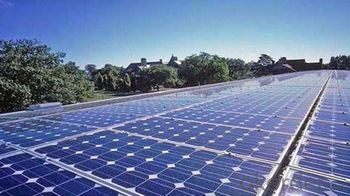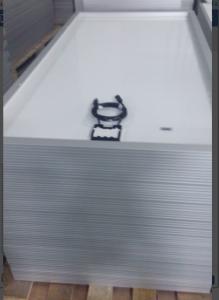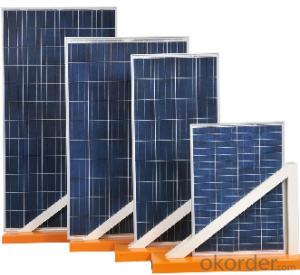Backyard Solar Panels:230w PV Monocrystalline Solar Modules 12V & 24V
- Loading Port:
- Shanghai
- Payment Terms:
- TT OR LC
- Min Order Qty:
- 50000 watt
- Supply Capability:
- 10000000 watt/month
OKorder Service Pledge
OKorder Financial Service
You Might Also Like
Specification
Specifications
250W mono pv solar panel solar module
We are manufacturer,can do OEM.
Certified to TUV,CE,ISO9001
Warranty:7 years
ITEM NO | MS-P250(60) |
Type of cell | Mono |
Maximum power (Wp) | 250W |
Maximum power voltage (V) | 30V |
Maximum power current (A) | 8.33A |
Open circuit voltage (V) | 36V |
Short circuit current (A) | 8.96A |
Number of cells (Pcs) | 60 |
Size of module (mm) | 1640*990*40mm |
Maximum system voltage (V) | 1000 |
Temperature coefficients of Isc (%) | + 0.1/ °C |
Temperature coefficients of Voc (%) | -0.38/ °C |
Temperature coefficients of Pm (%) | -0.47/ °C |
Tolerance Wattage (e.g. +/-3%) | +/-3% |
Surface Maximum Load Capacity | 60m/s(200kg/sq.m) |
Weight per piece (kg) | 18.5kg |
Junction Box Type | ( TUV ) |
Connectors and Cables Type | (TUV) |
Length of Cables (mm) | 900mm |
Cell Efficiency (%) | ≥15.5% |
Output tolerance (%) | +/-3% |
Frame (Material, Corners, etc.) | Aluminum |
Warranty | 7Years products warranty and 25 years 80% of power |
Standard Test Conditions | AM1.5 100mW/cm2 25°C |
FF (%) | 72% |
Products Details show:



Limited Warranty:
7years limited warranty on material and workmanship
25 years limited warrranty of 80% power output
(For detailed please refere to Limited Warranty Certificatd issued by our company) The speicification please find contact us at any time!
Payment Terms
Payment Terms | T/T | EXW | 30% T/T in advance, paid the balance before shipment |
FOB | |||
CFR(C&F) | 30% T/T in advance, paid the balance against copy of B/L | ||
CIF | |||
L/C | L/C amount above 50,000 usd, we can accept L/C at sight | ||
West Union | Amount lower than 5000usd | ||
Paypal | |||
Delivery time | 7~10days after receiving payment for one container | ||
Temperature Characteristics
| Nominal Operating Cell Temperature (NOCT) | 45±2°C |
Temperature Coefficient of Pmax | -0.44 %/°C |
| Temperature Coefficient of Voc | -0.33 %/°C |
| Temperature Coefficient of Isc | 0.055 %/°C |
Packing Configuration
| Container | 20’ GP | 40’ GP |
| Pieces per pallet | 26 | 26 |
| Pallets per container | 10 | 22 |
| Pieces per container | 260 | 572 |
FAQ
Q 1. what's the payment term?
A. We accept TT,30% deposit and 70% balance agaisnt copy of BL
Q 2. how's the delivery time ?
A. usually it will take about 25 days for production
Q 3. tell me the standard of package?
A. For the small capacity, it use carton, but for big capacity, we will use strong wooden case for protection
Q 4. what kind of material of transformer?
A. we have two types, one 100% copper and the other is copper with aluminum.It depends on your requirment. In fact,those two have no difference if normal work well. Only except the longlife. Copper is better and also higer price.
Q 5.Could you offer Form A or C/O ?
A. It totally not a problem. We can prepare relative documents to forgin affairs office or other office to apply for this certificate.
Q 6.Would you accept to use our logo ?
A.If you have good quantity,it absolute no problem to do OEM.
Q 7.We want to know month capacity.
A. It depends on which model.For example for relay type small capacity , month capacity can reach near 20000pcs and big capacity near 3000pcs.
Q 8.Where is your market?
A. Our products are popular in russia, indonisia, Philippines,italy, america, pakistan and so on.Some
of them are our regular customers and some of them are developing. We hope you can join us and make mutural benifit from our cooperation.
- Q: my solar panel is 5v 50 mA, and im making iphone USB charger so i need to connect + with 00 ohm resister and to data - and + so what resister will be okay..?
- Just connect the 5 volts out of the panel directly to the iphone via an USB connector. BUT, is the panel output always 5 volts, ±0.25 volts? Because that is the USB specification, and anything outside of those values could damage your iphone. And solar panels are known for their wide swings in voltage. Bottom line, resistor not needed, and you need to be positive you supply the correct voltage to the iphone. Best way to do that is to start with a solar panel that puts out at least 7 volts and use a LM7805 regulator. The only resistors needed are those to tie the data lines into a certain combination of resistance and voltage so that the iphone is fooled into thinking that a proper USB is connected. That would NOT involve a 00 ohm resistor. Search online for the proper values and connections. edit: are you repeating your same inane question with a different account? That is totally against the rules and could get you suspended.
- Q: Can solar panels be installed in areas with high pollution levels?
- Yes, solar panels can be installed in areas with high pollution levels. While pollution can reduce the efficiency of solar panels to some extent by blocking sunlight, they can still generate electricity even under such conditions. Regular maintenance and cleaning can help mitigate the impact of pollution on the performance of solar panels, making them a viable option even in areas with high pollution levels. Additionally, installing solar panels can help combat pollution by promoting the use of clean, renewable energy sources.
- Q: Can solar panels be installed on a hospital or healthcare facility?
- Yes, solar panels can be installed on a hospital or healthcare facility. Installing solar panels on such facilities can help reduce carbon emissions and energy costs, while also providing a reliable and sustainable source of electricity. Additionally, the use of solar energy aligns with the healthcare industry's commitment to promoting environmental sustainability and reducing the overall carbon footprint.
- Q: Can solar panels be installed on a fire station or emergency services building?
- Yes, solar panels can be installed on a fire station or emergency services building. In fact, many fire stations and emergency services buildings have embraced solar energy as a sustainable and cost-effective solution for their power needs. Solar panels can be installed on rooftops, parking lots, or open spaces surrounding these buildings to harness solar energy and generate electricity. This helps reduce their reliance on traditional energy sources, lowers operating costs, and contributes to a cleaner and greener environment.
- Q: Can solar panels be installed in areas with high wind speeds?
- Yes, solar panels can be installed in areas with high wind speeds. However, it is important to ensure that the solar panels are designed and installed to withstand the specific wind conditions of the area. This may involve using appropriate mounting systems and anchoring techniques to secure the panels effectively. Additionally, regular maintenance and inspections should be conducted to ensure the panels remain secure and efficient in such conditions.
- Q: Can solar panels be installed on a government building or facility?
- Yes, solar panels can be installed on a government building or facility. In fact, many government entities have already started incorporating solar energy as a sustainable and cost-effective solution to meet their energy needs. Solar panels not only help reduce carbon emissions but also provide long-term savings on electricity bills.
- Q: Is this a good kit for building a solar panel?
- Guide okorder /
- Q: Can solar panels be damaged by hail or other flying debris?
- Yes, solar panels can be damaged by hail or other flying debris. Hailstones, in particular, can cause cracks, dents, or even punctures on the surface of solar panels, reducing their efficiency or functionality. To mitigate the risk of damage, many solar panels are designed to withstand certain levels of impact and are typically tested for durability. Additionally, some solar panel installations utilize protective measures, such as tempered glass or anti-hail nets, to minimize potential damage caused by hail or flying debris.
- Q: Could you have a solar panel in space that would transmit electricity remotely? Maybe have some kind of receiving antenna to pick up the energy? Perhaps there could be a string of them orbiting the Earth?Why wouldn't that work?
- Absolutely. Many satellites and other spacecraft that have been launched throughout history carry solar panels to power themselves. The International Space Station alone has hundreds of square meters of solar panels. Transmitting the power from one place to another wirelessly is a bit more difficult, but not fundamentally impossible. So far we don't have any good technology to do it over long distances. But we're getting there. One proposed future source of power is 'solar power satellites', orbiting devices that would collect sunlight and turn it into a microwave laser that would be fired down to the Earth and collected in a giant dish kind of like a radio telescope. The idea is that this would be non-polluting, environmentally friendly, reliable, would help to boost investment in space technologies, and wouldn't take up the large amounts of land area required for traditional solar power. However, some people have argued that it is a bad idea on the basis that if the laser accidentally missed the dish, and came down in an inhabited area, it might cause human fatalities or damage to the environment or human artifacts.
- Q: What is the most powerful solar panel made?
- Yeah lead acid is the desirable yet once you've a higher image voltaic setup like 200watts or extra you extremely want a cost controller in addition they favor to be vented because even as they're charged the produce hydrogen that once concentrated burns and is no longer good to respire in. the worst section about lithium ion is they imeadiatly commence to decompose once they're used so that they in straight forward words very last 2-4 years the position lead acid can very last over 2 years if good maintained.
Send your message to us
Backyard Solar Panels:230w PV Monocrystalline Solar Modules 12V & 24V
- Loading Port:
- Shanghai
- Payment Terms:
- TT OR LC
- Min Order Qty:
- 50000 watt
- Supply Capability:
- 10000000 watt/month
OKorder Service Pledge
OKorder Financial Service
Similar products
Hot products
Hot Searches
Related keywords






























